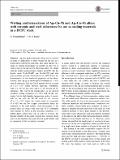Wetting and interactions of Ag–Cu–Ti and Ag–Cu–Ni alloys with ceramic and steel substrates for use as sealing materials in a DCFC stack
Abstract
Ag and Ag-based pseudo-alloys were evaluated in terms of application as metal brazes for the use in a hybrid direct carbon fuel cell stack. This paper reports on a series of wetting experiments on systems of pure Ag as well as Ag–Cu–Ti and Ag–Cu–Ni pseudo-alloys in contact with the widely used austenitic stainless steel SS316L, the ferritic steels Crofer22APU and Croffer22H and with polycrystalline partially stabilized zirconia (TZ-3Y) for the determination of the interfacial properties of the above systems. Pure Ag in air showed poor wettability (θ >90°) with all substrates. The Ag–Cu–Ti pseudo-alloy in vacuum (P = 2.5 x 10-3 mbar) showed improved wettability, with θ = 40°. for the steels and θ =50°. for the TZ-3Y substrates. The Ag–Cu–Ni pseudo-alloy in air showed excellent wetting properties (θ <10°) with all the substrates, but its high liquidus temperature makes it unsuitable for use with the SS316L steel. In low vacuum (P = 1.5 x 10-1 mbar), the contact angle was increased (θ = 65°) but the low oxygen concentration limits the oxidation of the steel surface. Selected systems of the pseudo-alloys in contact with steel and TZ-3Y substrates were treated for 120 h in the operating conditions of a hybrid direct carbon fuel cell, in order to evaluate the thermal stability of the joints. Despite the reactions taking place on the interface, the joints showed good stability and no separation of the two phases occurred.
Citation
Triantafyllou , G & Irvine , J T S 2016 , ' Wetting and interactions of Ag–Cu–Ti and Ag–Cu–Ni alloys with ceramic and steel substrates for use as sealing materials in a DCFC stack ' , Journal of Materials Science , vol. 51 , no. 4 , pp. 1766-1778 . https://doi.org/10.1007/s10853-015-9536-5
Publication
Journal of Materials Science
Status
Peer reviewed
ISSN
0022-2461Type
Journal article
Description
The authors would like acknowledge the financial support received from the Engineering and Physical Sciences Research Council [EP/K015540/1] and the European Coal and Steel Community [RFCR-CT-2011-00004].Collections
Items in the St Andrews Research Repository are protected by copyright, with all rights reserved, unless otherwise indicated.

